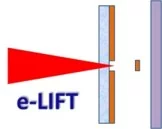Abstract:
The development of organic electronic requires a non contact digital printing process. The European funded e-LIFT project investigated the possibility of using the Laser Induced Forward Transfer (LIFT) technique to address this field of applications. This process has been optimized for the deposition of functional organic and inorganic materials in liquid and solid phase, and a set of polymer dynamic release layer (DRL) has been developed to allow a safe transfer of a large range of thin films. Then, some specific applications related to the development of heterogeneous integration in organic electronics have been addressed. We demonstrated the ability of LIFT process to print thin film of organic semiconductor and to realize Organic Thin Film Transistors (OTFT) with mobilities as high as 4 10-2 cm2.V-1.s-1 and Ion/Ioff ratio of 2.8 105. Polymer Light Emitting Diodes (PLED) have been laser printed by transferring in a single step process a stack of thin films, leading to the fabrication of red, blue green PLEDs with luminance ranging from 145 cd.m-2 to 540 cd.m-2. Then, chemical sensors and biosensors have been fabricated by printing polymers and proteins on Surface Acoustic Wave (SAW) devices. The ability of LIFT to transfer several sensing elements on a same device with high resolution allows improving the selectivity of these sensors and biosensors. Gas sensors based on the deposition of semiconducting oxide (SnO2) and biosensors for the detection of herbicides relying on the printing of proteins have also been realized and their performances overcome those of commercial devices. At last, we successfully laser-printed thermoelectric materials and realized microgenerators for energy harvesting applications.
Keywords: Laser induced forward transfere; Laser printing; e-LIFT Project;
Facility: ENE, LMX, Thin Films and Interfaces
Reference: Ph. Delaporte; A. Ainsebaa; A.-P. Alloncle; M. Benetti; C. Boutopoulos; D. Cannata; F. Di Pietrantonio; V. Dinca; M. Dinescu; J. Dutroncy; R. Eason; M. Feinaugle; J.-M. Fernández-Pradas; A. Grisel; K. Kaur; U. Lehmann; T. Lippert; C. Loussert; M. Makrygianni; I. Manfredonia; T. Mattle; J.-L. Morenza; M. Nagel; F. Nüesch; A. Palla-Papavlu; L. Rapp; N. Rizvi; G. Rodio; S. Sanaur; P. Serra; J. Shaw-Stewart; C. L. Sones; E. Verona; I. Zergioti, Proc. of SPIE Vol., 8607, 86070Z-1 (2013)
Read full article: here
Facility: ENE, LMX, Thin Films and Interfaces
Reference: Ph. Delaporte; A. Ainsebaa; A.-P. Alloncle; M. Benetti; C. Boutopoulos; D. Cannata; F. Di Pietrantonio; V. Dinca; M. Dinescu; J. Dutroncy; R. Eason; M. Feinaugle; J.-M. Fernández-Pradas; A. Grisel; K. Kaur; U. Lehmann; T. Lippert; C. Loussert; M. Makrygianni; I. Manfredonia; T. Mattle; J.-L. Morenza; M. Nagel; F. Nüesch; A. Palla-Papavlu; L. Rapp; N. Rizvi; G. Rodio; S. Sanaur; P. Serra; J. Shaw-Stewart; C. L. Sones; E. Verona; I. Zergioti, Proc. of SPIE Vol., 8607, 86070Z-1 (2013)
Read full article: here

